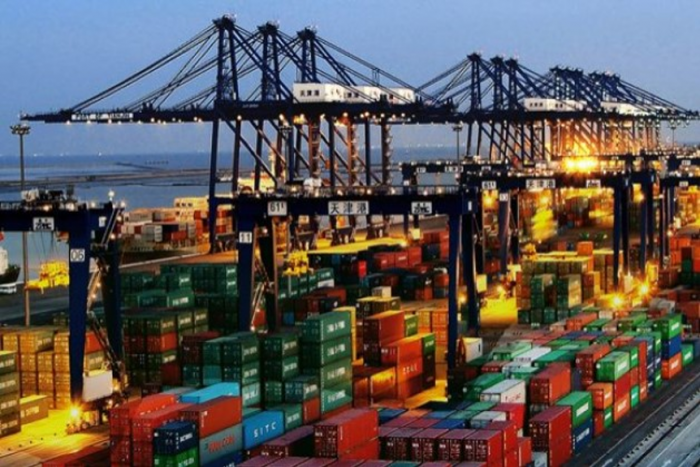The latest Customs trade data from China has revealed a mixed picture for the world’s second largest economy on Friday. Exports rose for a second month in May, but imports grew by a far smaller amount.
Outbound shipments were up 7.6% year-on-year last month, providing relief for factory owners, but analysts noted that with imports up by just 1.8%, from an 8.4% hike in April, it is clear that domestic consumption is still fragile.
They say questions remain on whether export sales are sustainable, while a protracted property crisis has led to persistent weakness in domestic demand – a factor highlighted again in last month’s imports figures.
ALSO SEE: China’s Clean Energy Spending Set to Match US-Europe Combined
“China’s exports maintained strong year-to-date growth momentum in May, which mainly reflects the continuing large global market share of Chinese goods and renminbi (yuan) exchange advantage, as well as exporters shipping early ahead of tariff increases in export markets,” Bruce Pang, chief China economist at Jones Lang LaSalle, said.
The export figure beat a forecast 6.0% increase in a Reuters poll of economists and a 1.5% rise seen in April, though growth was likely also aided by a lower base of comparison, after rising interest rates and inflation in the US and Europe squeezed external demand in the previous year.
Over recent months, a flurry of data has shown different parts of the $18.6 trillion economy recovering at varying speeds, heightening uncertainty about the outlook.
While first-quarter growth blew past forecasts and strong March export and output data suggested improving global demand might aid officials’ efforts to get the economy back on an even keel, more recent indicators reflecting soft domestic consumption have eroded much of that earlier optimism.
Depressed domestic demand
Indeed, separate data for May on commodities imports also released on Friday highlighted a mixed picture of demand conditions at home, with purchases of crude oil and soybeans down year-on-year, while copper and iron ore saw a solid uptick.
A long-running property sector crisis remains the biggest drag on China’s economy, with low investor and consumer confidence hurting domestic consumption and undermining business activity.
However, Friday’s trade data should give authorities some breathing space as they continue their efforts to foster a broad-based economic recovery.
Analysts expect China to roll-out more policy support measures in the short term, while a government pledge to boost fiscal stimulus is seen helping shore up domestic demand.
The International Monetary Fund last month upgraded its China growth forecast for 2024 in line with Beijing’s growth target of “around” 5%, but warned of risks to the economy from the property sector troubles.
China’s stocks slipped as the better export numbers were eclipsed by a report that US lawmakers pushed to ban Chinese battery firms with ties to Ford and Volkswagen from exporting to the US.
High tech boost
Friday’s shipments data possibly also suggests a global cyclical upturn in the electronics sector is helping China’s sales of components and finished manufactured goods.
Integrated circuits exports from the Asian giant increased 28.4% year-on-year in value in May, according to Reuters calculations, in line with robust chip shipments from neighbouring South Korea last month, a leading indicator of China’s trade performance in technology sectors.
Beijing has come under growing criticism from the West that Chinese industrial overcapacity in technologically advanced and green sectors is flooding markets in the European Union and the United States, an assertion China has refuted and it has accused Washington and the EU of engaging in trade protectionism.
China’s trade surplus grew to $82.62 billion last month, compared with a forecast of $73 billion and $72.35 billion in April, which the US has repeatedly highlighted in the past as evidence of one-side trade favouring the Chinese economy.
Last month, the Biden administration unveiled steep tariff increases on $18 billion of exports, including a quadrupling of tariffs on Chinese new energy vehicles.
The China trade data shows vehicles exports, including chassis, increased 16.6% year-on-year by value last month.
“We expect exports to stay strong in the coming months, supported by a weaker real effective exchange rate. Foreign tariffs are unlikely to immediately threaten exports,” Zichun Huang, China economist at Capital Economics, said.
“If anything, they may boost exports at the margins as firms speed up shipments to front-run the duties.”
- Reuters with additional editing by Jim Pollard
ALSO SEE:
US, EU Must Act Jointly on China’s Industrial Overcapacity: Yellen
Biden Ramps US Tariffs on Chinese EVs, Metals, PV Cells, Chips
China Slams ‘Biased’ EU Over Electric Vehicle Imports Probe
Yellen Warns China on ‘Excess Production, Unfair Trade’
China Plans New Way to Measure Products’ Carbon Footprint
China Wind, Solar Capacity Set to Outstrip Coal For First Time
China’s Solar Sector Seen Facing Years of Oversupply, Low Prices
























